

4 Principles Of Student-Centered Learning. By TeachThought Staff.
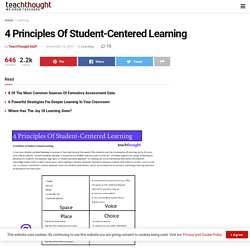
10 Characteristics of Learner Centered Experiences – Katie Martin. Education Reimagined defines the paradigm shift from teacher-centered to learner-centered as shifting how we see learners and their critical role in their own learning now, and throughout their lives.
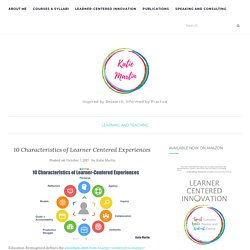
The critical shift is that “Learners are seen and known as wondrous, curious individuals with vast capabilities and limitless potential. This paradigm recognizes that learning is a lifelong pursuit and that our natural excitement and eagerness to discover and learn should be fostered throughout our lives, particularly in our earliest years.” When we focus on learners, connect to their interests, needs, and goals, we can create experiences that ignite curiosity, develop passion, and unleash genius. Tips for Teachers To Allow Students to Take Ownership of Their Learning. About ETR Community.

Getting Smart on Learner-Centered STEM. Authored by Getting Smart, in partnership with Harmony Public Schools Download Smart Bundle here What do you get when you mix project-based deeper learning, STEM, college prep and personalized learning in a small supportive environment?
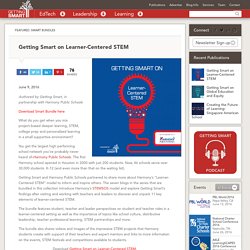
You get the largest high performing school network you’ve probably never heard of–Harmony Public Schools. The first Harmony school opened in Houston in 2000 with just 200 students. Now, 46 schools serve over 30,000 students K-12 (and even more than that on the waiting list). When Kids Have Structure for Thinking, Better Learning Emerges. Amidst the discussions about content standards, curriculum and teaching strategies, it’s easy to lose sight of the big goals behind education, like giving students tools to deepen their quantitative and qualitative understanding of the world.
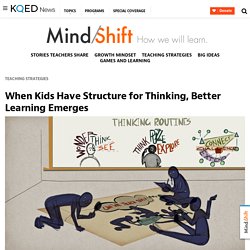
Teaching for understanding has always been a challenge, which is why Harvard’s Project Zero has been trying to figure out how great teachers do it. Some teachers discuss metacognition with students, but they often simplify the concept by describing only one of its parts — thinking about thinking. Teachers are trying to get students to slow down and take note of how and why they are thinking and to see thinking as an action they are taking. But two other core components of metacognition often get left out of these discussions — monitoring thinking and directing thinking. When a student is reading and stops to realize he’s not really understanding the meaning behind the words, that’s monitoring.
Learner-Centered Design – The Principal of Change. The things that really struck me about this post is regarding the notion of serving the end-user.
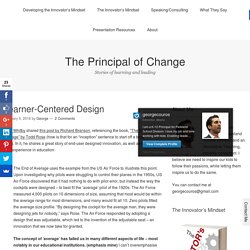
Similar to the pilots, schools need to be “learner-centred”, not “learning-centred”; there is a significant difference in these statements. I recently saw a quote being shared through social media and went something along the lines of “If a teacher explains the same thing to a child 100 times, and they still don’t understand, it is not the child that is a slow learner.” That really struck a chord with me. When I first shared my thoughts on the “8 Characteristics of the Innovator’s Mindset“, the first characteristic shared was “empathetic”. If that trait does not exist, how innovative could we truly be? Finding the Most Creative Ways to Help Students Advance At Their Own Pace.
In 2005, New Hampshire’s Department of Education set a policy requiring schools to implement a competency-based system, but didn’t define the specific skills each school would be expected to master.
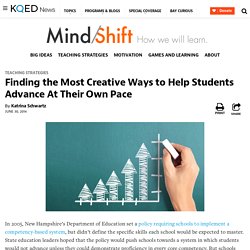
State education leaders hoped that the policy would push schools towards a system in which students would not advance unless they could demonstrate proficiency in every core competency. But schools across the state have interpreted the directive in very different ways and set those competencies both broadly and narrowly. “There wasn’t any training nor was there funding for it,” said Ryan Kaplan, Principal of Windham High School in New Hampshire.”
Every school had to figure it out on their own.” Windham is in its fifth year of existence and is still working for official accreditation from the state. The question of student pace — the main feature of a competency-based system — has not been the most important to Windham teachers and administrators. Bethany Bernasconi agrees. Student-Centered Learning. Student-Centered Learning. Why Trust Is A Crucial Ingredient in Shaping Independent Learners. Preparing students to be “college and career ready” is a catch phrase in many schools, but those same institutions often block large swaths of the internet in an attempt to protect students from acting inappropriately online.
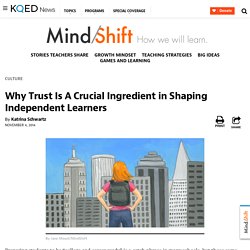
While well-intentioned, blocking useful digital tools prevents educators from guiding students through appropriate online behavior while still in the relative safety of school. College and job recruiters are seeking students who are creative problem solvers, collaborative workers and independent thinkers, but in many cases, rules prevent students from practicing those skills online. “When you try to use a computer in a school, it’s shocking what is blocked,” said Michelle Luhtala, head librarian at New Caanan High School in Connecticut during an edWeb webinar.
How One Teacher Changed for the Good of Her Students. The excerpt below is from the book “Passionate Learners: Giving Our Classrooms Back to Our Students,” by Pernille Ripp.
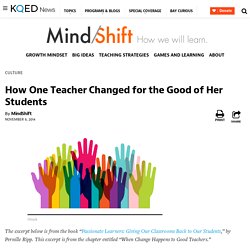
This excerpt is from the chapter entitled “When Change Happens to Good Teachers.” Four years ago, I realized that I needed to take responsibility for the damage I had done to students who came into my room loving (or at least liking) school and left diminished in some ways. Students Tell All: What It’s Like to Be Trusted Partners in Learning. Inquiry-based learning is not a new pedagogy, but it has come back into fashion in progressive education circles recently because of new emphasis on the power of students’ innate curiosity to drive learning.
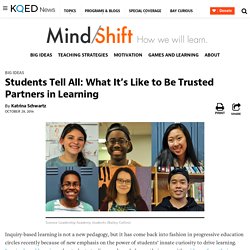
Inquiry-based learning asks students to discover knowledge on their own with guidance from their teachers. Rather than receiving information up front through lectures, students research guiding questions, ask their own follow-ups and get help along the way. Learning through inquiry requires more student agency and demands that teachers and administrators trust that students will ask when they need help. It also places the responsibility for completing tasks and meeting deadlines on the shoulders of students. Science Leadership Academy (SLA) in Philadelphia is a partnership between The School District of Philadelphia and The Franklin Institute.
Science Leadership Academy students spoke about their learning experience at the school. How the Power of Interest Drives Learning. Teaching Strategies Peninsula Park In recent years researchers have begun to build a science of interest, investigating what interest is, how interest develops, what makes things interesting, and how we can cultivate interest in ourselves and others.
They are finding that interest can help us think more clearly, understand more deeply, and remember more accurately. Edutopia. In the education world, the term student-centered classroom is one we hear a lot. And many educators would agree that when it comes to 21st-century learning, having a student-centered classroom is certainly a best practice. Whether you instruct first grade or university students, take some time to think about where you are with creating a learning space where your students have ample voice, engage frequently with each other, and are given opportunities to make choices. Guiding Questions Use these questions to reflect on the learning environment you design for students: In what ways do students feel respected, feel valued, and feel part of the whole group? Balancing Teacher Roles. How Students Lead the Learning Experience at Democratic Schools. Courtesy of Fairhaven School While teaching at Catholic and public schools in the 1990s, Mark McCaig and his wife, Kim, grew increasingly frustrated with the amount of time they were having to devote to managing behavior and teaching material that didn’t interest students.
Putting the student-centric approach in focus. VCRs and VHS tapes, film, CDs, movie rental stores, phone books, dictionaries, encyclopedias, fax machines and pay phones. They served a purpose and paved the way for advancement. But now they're mostly gone, succumbing to a wave of acronyms: DVRs, MP3s, WAVs, MOVs, AVIs and URLs. What’s In and What’s Out in Education. 4 Steps to Becoming a Learner-Centered eLearning Professional.
4 Steps to Becoming a Learner-Centered eLearning Professional Take a moment to step back from your role as an eLearning designer, instructor, or course developer and focus on yourself as a learner. Answer these questions: How do you learn best? What learning activities are the most motivational to you? How do you interact with other learners? Reading Comprehension and Considerate Text, Teaching Today, Glencoe Online. Addressing Our Needs: Maslow Comes to Life for Educators and Students. In the mid-1950s, humanistic psychologist Abraham Maslow created a theory of basic, psychological and self-fulfillment needs that motivate individuals to move consciously or subconsciously through levels or tiers based on our inner and outer satisfaction of those met or unmet needs.
4 myths about student-centered learning. 5 Excellent Strategies to Teach Students how to Learn. " Give a man a fish and he'll eat for a day but teach him to fish and he'll eat for a lifetime " this quip summarizes the essence of education and learning. Teach students how to learn and they will learn for the rest of their lives.The focus should be on the process not the end product, but unfortunately today's educational system with its emphasis on high stake tests and standardized assessment puts the cart in front of the horse and turn students into empty pails that require filling up each time they are to pass a test.
5 Tools to Help Students Learn How to Learn. Helping students learn how to learn: That’s what most educators strive for, and that’s the goal of inquiry learning. Student-Centered Learning: The First Steps Are the Hardest Ones. Educator Melba Smithwick never had too much difficulty trying out new ideas. Froyd_Stu-CenteredLearning. Student-Centered Learning Strategies for Math and Other Subjects. Editor's Note: Paul Bogdan was once an old-fashioned lecturing teacher centered secondary math teacher who left teaching for 14 years to build computer systems. BYOD Is Shortest Path To Student-Centered Learning. By its very nature, BYOD is authentic. My Views on Creating a Student-Centered Classroom. Recently I worked with a team of coaches (@twilhelmus, @lawilhelmus, @MrBrianBobbitt, @juliesteve4, @TechECoach, @mrg_3, and @stacymath7) and put on a days worth of professional development on creating the student-centered classroom.
Jones-Student-Centered.pdf. Center of Learning: Summary. Teacherlib_student_11mar09. CultureShift.pdf. Integrating-Technology-with-Student-Centered-Learning?ext= Student-Centered Learning. Student-centered learning or student-centered learning is an approach to education focusing on the needs of the students, rather than those of others involved in the educational process, such as teachers and administrators.
This approach has many implications for the design of curriculum, course content, and interactivity of courses. AnYCreatingTechnology. TeacherCenteredVsLearnerCenteredParadigms. Teacher vs Learner centered instruction. How Can Teachers Create a Learner-Centered Environment? - Leading From the Classroom.